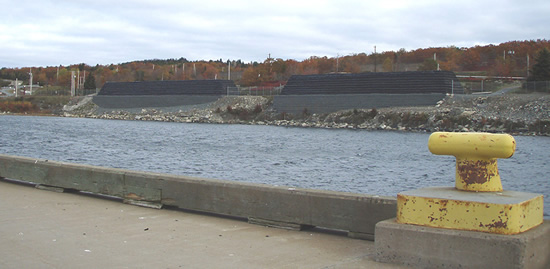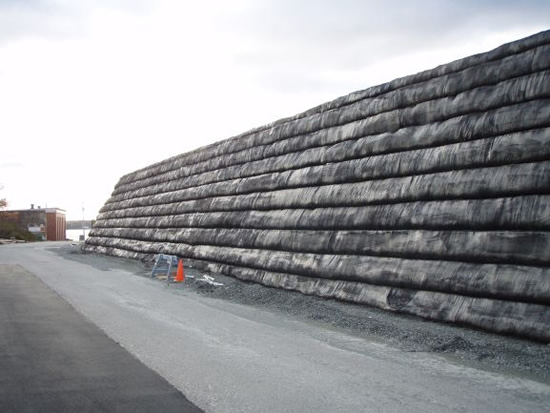

The Canadian Forces Ammunition Depot (CFAD) in Bedford, Nova Scotia has updated its facility with geosynthetic-supported blast walls. The hillside site, overlooking the Bedford Basin edge of Halifax Harbour, has previously required concrete protection barriers outside of each ammo bunker. New regulations, however, have prompted the facility to redesign its protection strategy with walls that would not fragment larger than 19 mm.
The ambitious engineering task led to the design of three conceptual approaches, put forth by Mitchelmore Engineering Co. Ltd. (Meco): anchored, cantilevered, and geotextile wall options. The successful design had to serve for 20 years, needed to be economical, minimize blast particles, be easy to construct, and reduce waste. Each wall also needed to be freestanding, which meant having four exposed outer walls.
With all of these design requirements taken into account, and factoring in the need for durability against potential blasts, three geotextile-wrapped earthen barriers were selected. An interior blast wall of reinforced concrete was also added to the site.
GEOTEXTILE BLAST WALLS
TenCate Mirafi® PET 100 polyester geotextile was specified for the geotextile-wrapped walls. The approach enabled a single material to be used for both the facing and reinforcement, which helped meet goals of economics and reduced material waste.
The maximum blast-risk particle size was limited by the gradation of the contained granular backfill, which was kept to 19 mm, per specification.
Each blast wall was built to 72 m long x 9 m wide x 6 m high, and each utilized 11 lifts of geotextile.
The approach simplified installation. Temporary forms helped expedite construction and the final wall was sprayed with an asphalt emulsion to enhance UV stability.
HISTORY OF DURABILITY
Geotextile durability is not new to blast protection applications. Building implosions frequently use geotextile wrap to retain debris on site. Also, various military bodies around the world have used geotextile-supported earth walls for quick installation and protection in combat zones.
For the CFAD site, the blast wall project has been important, and not only for the modernized design. The location was the scene of dangerous fires and explosions in July 1945 when the former magazine was impacted by a blast on a ship in the harbor. The area was also the scene of one of the worst waterside disasters in history when a heavily loaded munitions ship collided with another vessel in Halifax in 1917. As such, the communities are sensitive to safety designs while understanding that the island and province’s strategic position on the Atlantic makes it a key national defense point.
The new blast walls are providing the Canadian Department of National Defence (DND) a new and welcomed approach to high-strength protection, one that reduces wastes and costs while increasing construction efficiency and site safety.
ADDITIONAL NOTES
- TenCate Geosynthetics provided a qualified wall system technician for on-site technical support.
- Meco’s design received Honourable Mention recognition from the Nova Scotia Lt. Governors for Excellence in Engineering Awards for the CFAD update.
- Perry Mitchelmore (Meco) currently serves as the Chair of the Board of Directors for the Association of Consulting Engineering Companies – Canada (ACEC).
**
See also:











